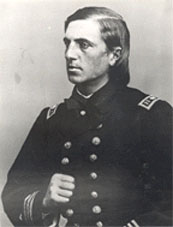| William Barker Cushing  Born: 4-Nov-1842 Born: 4-Nov-1842
Birthplace: Delafield, WI
Died: 17-Dec-1874
Location of death: Washington, DC [1]
Cause of death: unspecified
Remains: Buried, US Naval Academy, Annapolis, MD
Gender: Male
Religion: Christian
Race or Ethnicity: White
Sexual orientation: Straight
Occupation: Military Nationality: United States
Executive summary: Civil War naval hero Military service: US Navy (US Civil War) The American naval officer William Barker Cushing was born in Delafield, Wisconsin, on the 4th of November 1842. He entered the Naval Academy from New York in 1857, but resigned in March 1861. When, however, the Civil War began, he volunteered into the navy, was rated acting master's mate, and became a midshipman in October 1861, and a lieutenant in July 1862, serving in the North Atlantic blockading squadron. The work of blockade, and of harassing the Confederates on the coast and the rivers of the Atlantic seaboard, called for much service in boats, and entailed a great deal of exposure. Cushing was distinguished by his readiness to volunteer, his indefatigability, and by his good fortune, the reward of vigilance and intelligence.
The feat by which he will be remembered was the destruction of the Confederate ironclad Albemarle in the Roanoke river on the 27th of October in 1864. The vessel had done much damage to the Federal naval forces, and her destruction was greatly desired. She was at anchor surrounded by baulks of timber, and a cordon of boats had been stationed to row guard against an expected Federal attack. Lieutenant Cushing undertook the attack on her with a steam launch carrying a spar-torpedo and towing an armed cutter. He eluded the Confederate lookout and reached the Albemarle unseen. When close to he was detected, but he had time to drive the steam launch over the baulks and to explode the torpedo against the Albemarle with such success that a hole was made in her and she sank. Cushing's own launch was destroyed. He and the few men with him were compelled to take to the water; one was killed, another was drowned, Cushing and one other escaped, and the rest were captured. Cushing himself swam to the swamps on the river bank, and after wading among them for hours reached a Federal picket boat.
For destroying the Albemarle he was thanked by Congress and was promoted to be lieutenant-commander. On the 15th of January 1865 he took a conspicuous part in the land attack on the sea-front wall of Fort Fisher.
After the war he commanded the Lancaster (1866-7) and the Maumee (1868-9) in the Asiatic Squadron. In 1872 he was promoted commander at what was an exceptionally early age, but he died on the 17th of December 1874 of brain fever. He had suffered extreme pain for years before his death, and in fact broke down altogether under disease contracted in the discharge of his duty.
[1] Government Hospital for the Insane, Washington, DC.
Father: Milton Buckingham Cushing (physician, b. 1800, d. 22-Apr-1847, pneumonia)
Mother: Mary Barker Smith (b. 1807, d. 26-Mar-1891)
Brother: Alonzo Hereford Cushing (b. 19-Jan-1841, d. 3-Jul-1863, Gettysburg)
Brother: (d. 1871)
Wife: Katherine Louise Forbes (b. 1847, m. 22-Feb-1870, d. Jan-1910)
Daughter: May Louise Cushing (b. 1-Dec-1871, d. 1960)
Daughter: Katherine Abell Cushing (b. 11-Oct-1873, d. 1954)
High School: Fredonia Academy, Fredonia, NY (1856)
University: US Naval Academy, Annapolis, MD (1857-61)
Congressional Pages (1856)
Risk Factors: Sciatica
Requires Flash 7+ and Javascript.
Do you know something we don't?
Submit a correction or make a comment about this profile
Copyright ©2019 Soylent Communications
|